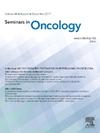液体活检:肿瘤学的创新工具。我们的立场是什么?
IF 3
3区 医学
Q2 ONCOLOGY
引用次数: 0
摘要
液体活检(LB)是肿瘤组织活检(TB)的理想替代品,其目的是获得有关患者预后和个性化治疗的有用信息。这项技术使得从生物体液中分离循环肿瘤细胞、循环肿瘤DNA和其他分子成为可能。液体活检最常用的液体是血液,但根据具体情况,可能需要将肿瘤成分从其他生物液体(如尿液、胸腔积液、脑脊液等)中分离出来。液体活检的主要优点是手术的微创性和分析所有肿瘤克隆的可能性。限制包括分离肿瘤成分的困难,以及需要高度敏感的分析方法以避免技术伪影的风险。在我们的综述中,我们将重点描述循环肿瘤生物标志物,以说明可从生物液体,特别是血液中获得的各种信息。然后,我们将讨论适用于循环肿瘤DNA (ctDNA)鉴定和分析的先进生物技术,研究分析方法的潜力和局限性,以及液体活检在癌症诊断、监测和治疗预测方面的临床适用性。此外,我们将探索策略,以增强这种有价值的替代更具侵入性的组织活检,专注于正在进行的临床研究,目前批准的测试和指南建议。本文章由计算机程序翻译,如有差异,请以英文原文为准。
Liquid biopsy: An innovative tool in oncology. Where do we stand?
The Liquid Biopsy (LB) represents an ideal surrogate of tumor Tissue Biopsy (TB) when the aim is to obtain useful information on patient prognosis and personalized therapy. This technique renders it possible to isolate circulating tumor cells, circulating tumor DNA and other molecules from biological fluids. The most commonly used fluid for liquid biopsy is blood, but depending on the case it could be necessary to isolate the tumor components from other biological fluids such as urine, pleural effusion, cerebrospinal fluid, and others. The main advantages of liquid biopsy are the minimally invasive nature of the procedure and the possibility of analyzing all tumor clones. Limitations include difficulties in the isolation of tumor components and the requirement for highly sensitive analysis methods to avoid the risk of technical artifacts. In our review we will focus on describing circulating tumor biomarkers to illustrate the variety of information that can be obtained from biological fluids, particularly blood. We will then discuss the advanced biotechnological techniques suitable for the identification and analysis of Circulating Tumor DNA (ctDNA), examining both the potential and limitations of analytical methods and the clinical applicability of liquid biopsy for cancer diagnosis, monitoring, and therapeutic prediction. Additionally, we will explore strategies to enhance this valuable alternative to the more invasive tissue biopsy, with a dedicated focus on ongoing clinical studies, currently approved tests, and guideline recommendations.
求助全文
通过发布文献求助,成功后即可免费获取论文全文。
去求助
来源期刊

Seminars in oncology
医学-肿瘤学
CiteScore
6.60
自引率
0.00%
发文量
58
审稿时长
104 days
期刊介绍:
Seminars in Oncology brings you current, authoritative, and practical reviews of developments in the etiology, diagnosis and management of cancer. Each issue examines topics of clinical importance, with an emphasis on providing both the basic knowledge needed to better understand a topic as well as evidence-based opinions from leaders in the field. Seminars in Oncology also seeks to be a venue for sharing a diversity of opinions including those that might be considered "outside the box". We welcome a healthy and respectful exchange of opinions and urge you to approach us with your insights as well as suggestions of topics that you deem worthy of coverage. By helping the reader understand the basic biology and the therapy of cancer as they learn the nuances from experts, all in a journal that encourages the exchange of ideas we aim to help move the treatment of cancer forward.
 求助内容:
求助内容: 应助结果提醒方式:
应助结果提醒方式:


